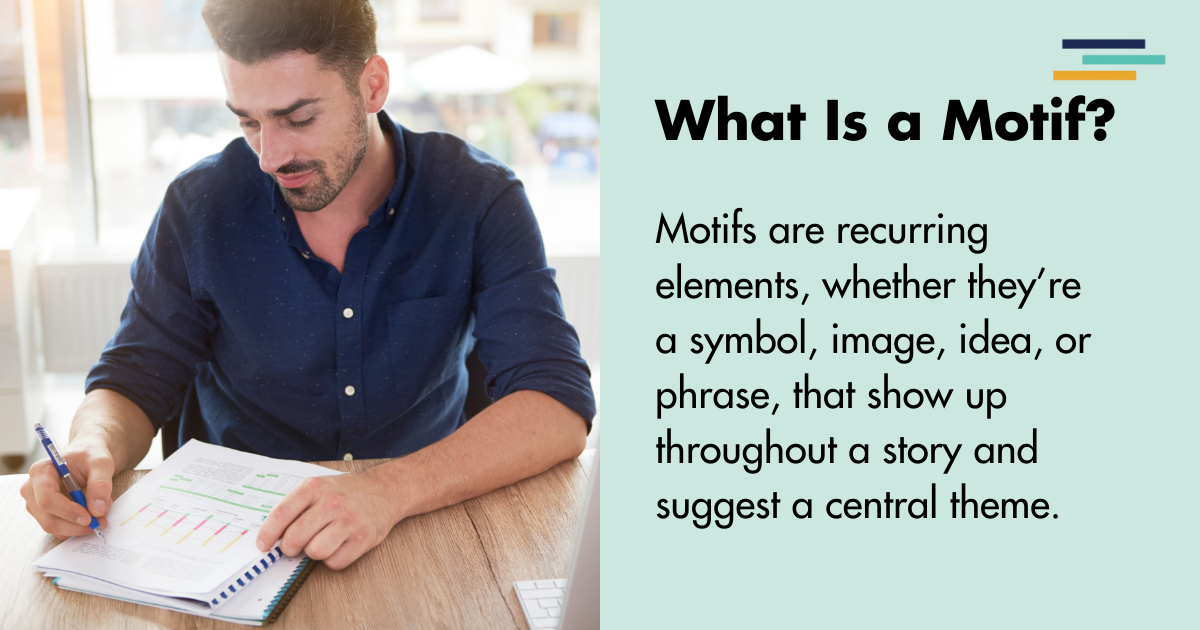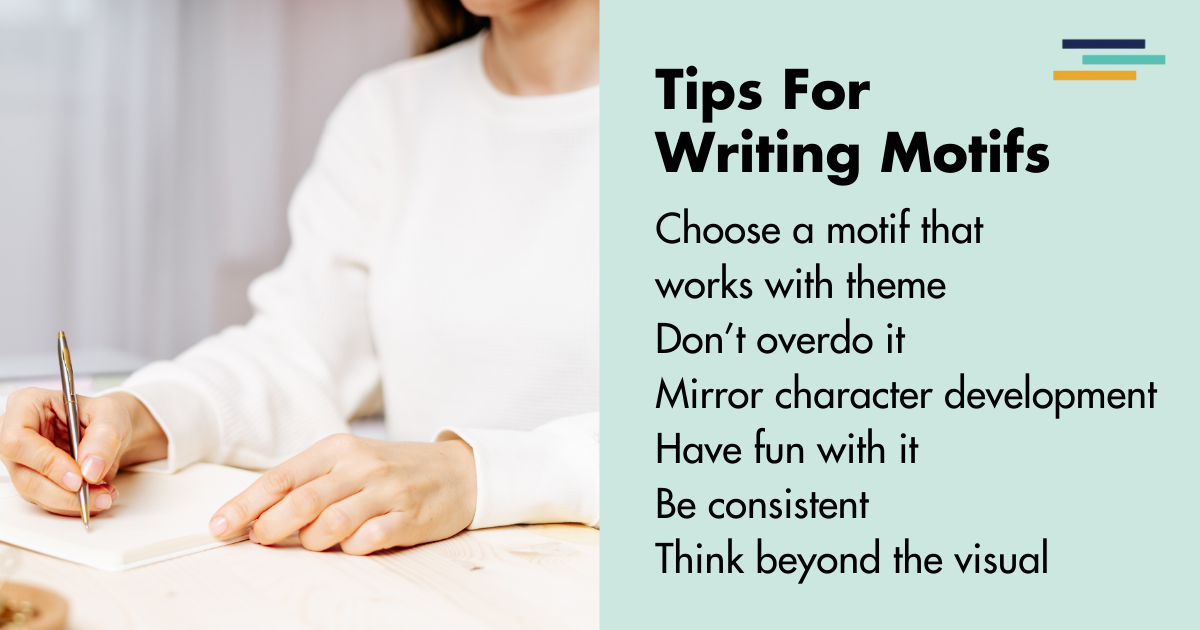
If you’ve ever wondered why certain images or symbols seem to pop up repeatedly in your favorite books, it’s not just coincidence.
These recurring elements, called motifs, are the secret sauce that adds depth and meaning to a story. Much like that catchy song that won’t leave your head (looking at you, Baby Shark), motifs subtly sneak into the narrative, reinforcing themes and helping to connect the dots for readers.
So, what exactly is a motif, and how can you use it to take your writing to the next level?
Great question.
Let’s dive in.
What Is a Motif in Literature?
A motif is like the trusty sidekick of the literary world. It might not always get the spotlight, but its presence helps shape the narrative in powerful ways.
Motifs are recurring elements, whether they’re a symbol, image, idea, or even a phrase, that show up throughout a story, subtly nudging the reader toward the central themes. It’s the literary equivalent of an elbow nudge and a knowing wink.
Motif Definition Literature
We can define a motif as any recurring element in a literary work that holds symbolic meaning.
Think of it like that one shirt in your wardrobe you keep wearing because it just works with everything. It keeps showing up, but for a good reason. In literature, a motif repeats to emphasize the story’s themes or to highlight the internal struggles of the characters.
Motifs Meaning
The meaning behind a motif lies in its ability to provide an extra layer of understanding for the reader.
For example, if an author drenches a novel in images of storms, the motif might represent the emotional chaos in the characters’ lives (or maybe the author just really likes gloomy weather).
Motifs work like breadcrumbs, guiding the reader toward a deeper understanding of the story’s central ideas without smacking them over the head with it.

What Is a Recurring Motif?
A recurring motif is exactly what it sounds like. An element that shows up multiple times throughout the story, often in different forms.
Imagine it like a recurring guest star on your favorite TV show.
Every time it appears, it reminds you of something important, whether it’s the character’s emotional growth, the looming sense of danger, or just that the TV show writers really, really like that guest star.
Examples of Motifs in Literature
Some of the best-known works in literature use motifs to great effect. Whether or not you realize it, you’ve probably come across more motifs than you think. Let’s break down a few examples to show you how these literary gems work their magic.
1. The Green Light in The Great Gatsby by F. Scott Fitzgerald
Ah, the green light.
You’d think by the way Gatsby stares longingly at it, it must be the only light in town.
In The Great Gatsby, the green light at the end of Daisy Buchanan’s dock represents Gatsby’s hopes, dreams, and all-around obsession with a future that’s just out of reach.
Spoiler alert: Things don’t go too well for Gatsby, and that green light ends up representing the futility of chasing dreams that might not be as shiny as they seem. If only someone had handed him a pair of binoculars.
2. The Mockingbird in To Kill a Mockingbird by Harper Lee
In To Kill a Mockingbird, the motif of the mockingbird symbolizes innocence and the destruction of that innocence.
Atticus Finch explains that killing a mockingbird is a sin because all they do is sing and bring beauty to the world.
Throughout the novel, Lee links characters like Tom Robinson and Boo Radley to the mockingbird. They’re innocent people harmed by a world that doesn’t understand them.
It’s a motif that keeps on reminding us…
Maybe, just maybe, we should be a little kinder.
3. Blood in Macbeth by William Shakespeare
Blood in Macbeth isn’t just for those who like their Shakespeare with a side of gore. It’s a potent symbol of guilt.
From the moment Macbeth takes that fateful step of murdering King Duncan, blood becomes a constant reminder of the consequences of his actions. It stains his hands, haunts his dreams, and literally drives Lady Macbeth to madness.
As the bodies pile up, so do the references to blood, reminding the audience that guilt, much like a stubborn stain, is hard to wash away.
4. Eyes in The Handmaid’s Tale by Margaret Atwood
In The Handmaid’s Tale, eyes aren’t just for seeing.
They’re for spying, judging, and controlling.
The motif of eyes represents surveillance and loss of freedom in the dystopian world of Gilead. Characters are constantly under watch, whether by the secret police known as “The Eyes” or through the phrase “Under His Eye,” a not-so-subtle reminder that Big Brother is, in fact, watching.
It’s a motif that keeps readers feeling just as trapped as Offred, which is exactly the point.
5. Light and Darkness in Romeo and Juliet by William Shakespeare
Light and darkness might seem like obvious opposites, but in Romeo and Juliet, they’re used as motifs to reflect the tension between love and tragedy.
Romeo constantly refers to Juliet as a source of light, “Juliet is the sun,” but the darkness of their families’ feud continually overshadows their love. It’s a classic case of “love versus doom,” with the motif of light and darkness highlighting the fleeting beauty of their relationship before, well, everything goes terribly wrong.

6. The Seasons in The Secret Garden by Frances Hodgson Burnett
If you’re looking for a motif that symbolizes change, look no further than the seasons in The Secret Garden.
As the garden comes to life in the spring, so do the novel’s characters.
Mary Lennox and Colin Craven both undergo transformations, mirroring the blooming flowers and the garden’s revival.
It’s a subtle yet powerful way to show that, just like nature, people can heal and grow if they’re given the right conditions (and maybe a few talking animals for good measure).
7. The Island in Lord of the Flies by William Golding
In Lord of the Flies, the island itself becomes a powerful motif, symbolizing both paradise and chaos. At first, the boys view the island as a kind of Eden.
A perfect place where they can play and live without adult supervision.
But as the story progresses, the island’s idyllic setting deteriorates into a nightmarish landscape, mirroring the boys’ descent into savagery.
The motif of the island represents isolation and the thin line between civilization and barbarism. The gradual shift from paradise to chaos is a constant reminder that beneath the surface, darker impulses always lie in wait.
8. The Paperweight in 1984 by George Orwell
In George Orwell’s 1984, the glass paperweight is a recurring motif that represents the fragile and fleeting nature of beauty, love, and privacy in the oppressive world of the Party.
Winston views the paperweight as a link to a time before the Party’s totalitarian control, and its beauty stands in stark contrast to the grim reality of his life. As Winston and Julia’s relationship blossoms, the paperweight becomes a symbol of their temporary sanctuary from the Party’s surveillance.
However, when someone shatters the paperweight during their arrest, it marks the end of their brief escape from oppression, driving home the idea that freedom and beauty are as fragile as the glass itself.
9. The Whale in Moby-Dick by Herman Melville
In Moby-Dick, the white whale, Moby Dick, serves as a multifaceted motif symbolizing the destructive forces of nature, obsession, and the unknown. Captain Ahab’s relentless pursuit of the whale becomes symbolic of man’s struggle to conquer the uncontrollable forces of the world.
The whale is not just a literal creature but a representation of Ahab’s personal vendetta, as well as the larger theme of man versus nature.
The recurrence of the whale motif throughout the novel serves as a reminder of Ahab’s all-consuming obsession and the destructive path it leads him down.
10. The Red A in The Scarlet Letter by Nathaniel Hawthorne
In The Scarlet Letter, the scarlet “A” that Hester Prynne is forced to wear is a motif loaded with multiple layers of meaning.
At first, it represents Hester’s shame and public punishment for committing adultery. As the story progresses, however, the “A” comes to symbolize more than just Hester’s “sin.” It also represents her strength, resilience, and defiance against a society that seeks to define her solely through her mistakes.
By the end of the novel, the scarlet letter has transformed into a symbol of Hester’s identity and individuality, showing how a motif can develop alongside a character’s journey.
Tips for Writing Motif Literary Device
So, now that you’ve seen how motifs can transform a story, how can you use them in your own writing without coming across like you’re trying too hard?
Here are some tips to help you strike the perfect balance.
1. Choose a Motif That Works with Your Theme
Motifs are like the icing on the thematic cake. They should complement, not overpower.
If your story revolves around redemption, maybe a recurring image of light or fire could work as a motif to symbolize hope and transformation. The key is to make sure the motif fits seamlessly with the theme rather than sticking out like a sore thumb.
2. Don’t Overdo It
Subtlety is key with motifs.
You don’t want readers feeling like you’re waving a gigantic neon sign that says, “LOOK, HERE’S THE MOTIF!”
Introduce your motif early on, then let it pop up naturally at key moments. Like a good party guest, it should show up just enough to make an impression, but not so often that people wish it would leave already.
3. Let the Motif Develop
One way to keep your motif from getting stale is to let it strengthen throughout the story.
Maybe the recurring motif starts out as something positive, like water representing purity, but over time it changes to reflect the character’s journey, perhaps turning into a symbol of danger or chaos.
This keeps things fresh and adds layers of meaning as the story progresses.
4. Use Motifs to Mirror Character Development
Motifs can be a great tool to reflect your character’s growth.
Think of how the garden in The Secret Garden mirrors the healing process of Mary and Colin.
As the garden transforms from a lifeless patch of earth to a thriving paradise, so too do the characters move from isolation to connection. A well-chosen motif can highlight a character’s internal journey without spelling it out for the reader.
5. Have Fun with It
Not all motifs have to be dark and serious. If your story calls for it, don’t be afraid to experiment with quirky or unexpected motifs.
Maybe there’s a recurring tune that all the characters keep humming, or an object that keeps showing up at important moments. Just make sure it adds to the narrative and doesn’t feel like a random running joke…
Unless, of course, your motif is literally a running joke.

6. Keep It Consistent
While it’s important not to overdo your motif, it’s equally essential to keep it consistent throughout your story.
Think of it as the literary version of background music.
You don’t want to blast it every five minutes, but you also don’t want it to disappear completely after the first chapter.
Place your motif in key moments that align with your story’s emotional beats or thematic shifts. A well-placed motif should remind readers of the deeper layers of your narrative without feeling like you’ve forgotten it halfway through.
7. Use Subtle Variations
A motif doesn’t always have to appear in exactly the same form every time. In fact, using subtle variations can add richness to your story.
For example, if your motif is a recurring image of the moon, you might show it as full in one scene, crescent in another, and obscured by clouds in yet another.
These variations can reflect the changing emotional landscape of your characters or the plot. It’s like adding a little spice to a familiar recipe. Just enough to keep things interesting without losing the core flavor.
8. Tie the Motif to Your Climax
The climax of your story is often where everything comes together, so it’s a great place to bring your motif into sharp focus.
If your motif has been quietly building throughout the narrative, its appearance at the climax can pack a powerful punch.
Whether it’s a symbol of the protagonist’s final realization, a visual cue that echoes a recurring theme, or even a repeated phrase that suddenly takes on new meaning, using your motif at the climax can make it feel like an integral part of the story rather than just a background element.
9. Use the Motif to Foreshadow
Motifs can be a subtle way to foreshadow important events or revelations in your story.
If you’re crafting a mystery or a thriller, a recurring motif might hint at something significant long before the big reveal. For example, a character who keeps noticing broken mirrors could be subconsciously reflecting their own fractured identity, which later plays into the resolution.
Using motifs to foreshadow can add a layer of suspense and keep readers on their toes, eager to uncover the deeper connections.
10. Think Beyond the Visual
While many motifs are visual, don’t be afraid to explore other sensory elements. Sound, touch, smell, and even taste can all be effective motifs if used thoughtfully.
For instance, the recurring sound of a ticking clock might symbolize the passage of time or impending doom. Similarly, a character who frequently encounters the scent of jasmine might get reminded of a lost love, creating a poignant emotional thread throughout the story.
Sensory motifs can evoke powerful reactions from readers and help immerse them more fully in your world.
And finally, always remember that the story comes first. Focus on:
- Creating engaging characters
- Penning interesting plots
- Structuring solid settings
A tool like Fictionary helps you turn your draft into an interesting story readers love. So, with a strong narrative foundation, your writing can truly shine.


